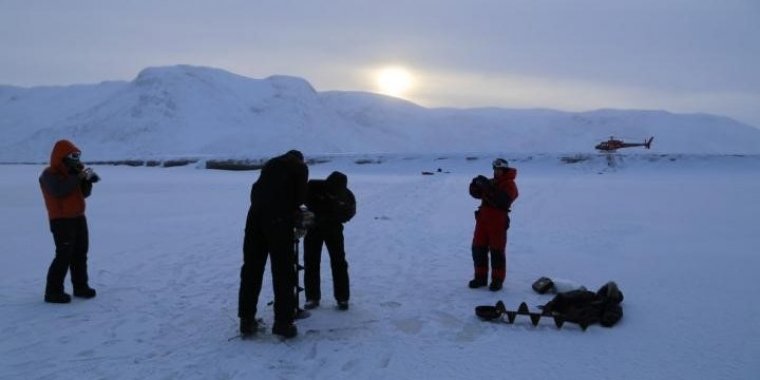| News / Science News |
Greenland Ice Sheet meltwater can flow in winter, too
Liquid meltwater can sometimes flow deep below the Greenland Ice Sheet in winter, not just in summer, according to new research.

An ice auger is used to drill a borehole through Isortoq River seasonal ice cover in Greenland. Photo: Lincoln Pitcher
It is often assumed that Greenland's drainage system lies dormant during winter. The new findings highlight a need for year-round Arctic hydrologic investigations, not just in summer.
"This observation raises questions for the Greenland research community and motivates the need for future work on wintertime hydrology in Greenland," said lead author Lincoln Pitcher of the University of Colorado Boulder.
When evidence suggested that some of Greenland's glaciers were storing meltwater through the winter, Pitcher set out for southwest Greenland to see if any of this meltwater was also leaving the ice sheet during winter.
He and his colleague Colin Gleason of the University of Massachusetts at Amherst dragged a ground-penetrating radar across frozen rivers downstream of the edge of the ice sheet and drilled boreholes to see if any water was leaving the ice sheet and flowing beneath river ice.
They surveyed rivers draining five Greenland Ice Sheet outlet glaciers and discovered meltwater flowing at one site, the Isortoq River.
In summertime, the Isotoq drains meltwater from the Isunguata Sermia glacier. In winter, the river appears frozen, but Pitcher and Gleason found slowly flowing liquid water there.
It was "a trickle, not a torrent," Pitcher said, and the water was flowing below half a meter of ice while temperatures were well below zero. Pitcher and Gleason collected water samples, and geochemical analysis indicated that it had come from beneath the ice sheet itself.
It is possible that the bed of the Greenland Ice Sheet can stay wet and drain small amounts of water year-round, the team concluded.
The finding is important for understanding how meltwater from the ice surface moves through the ice sheet, is retained and freezes again, or ultimately drains into rivers or the global ocean. (National Science Foundation)
YOU MAY ALSO LIKE





